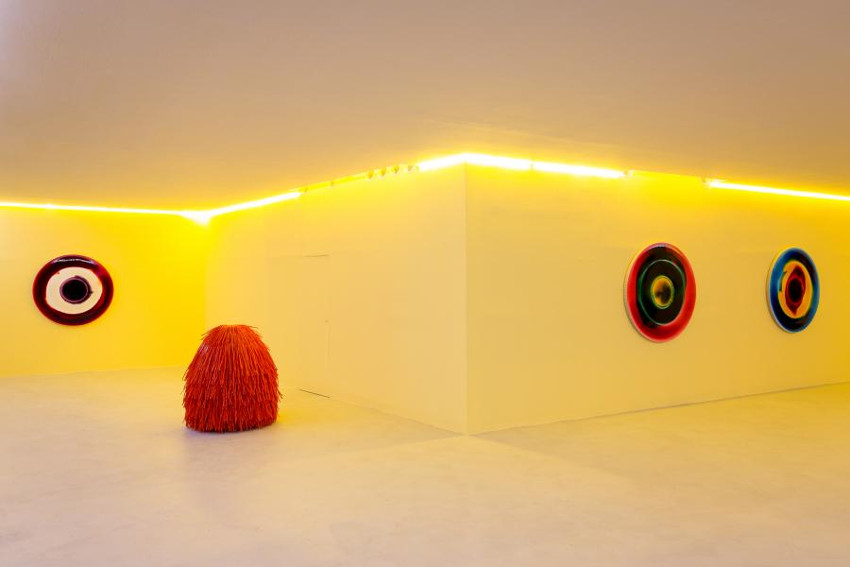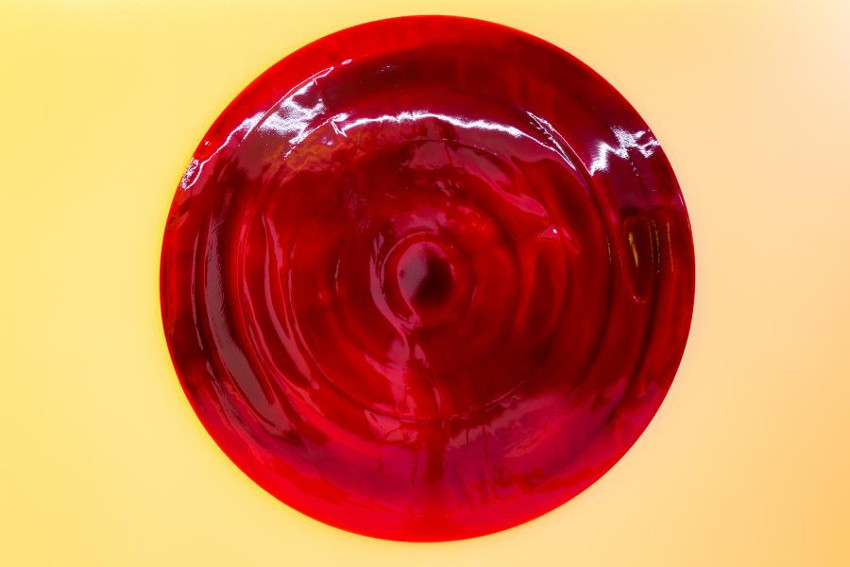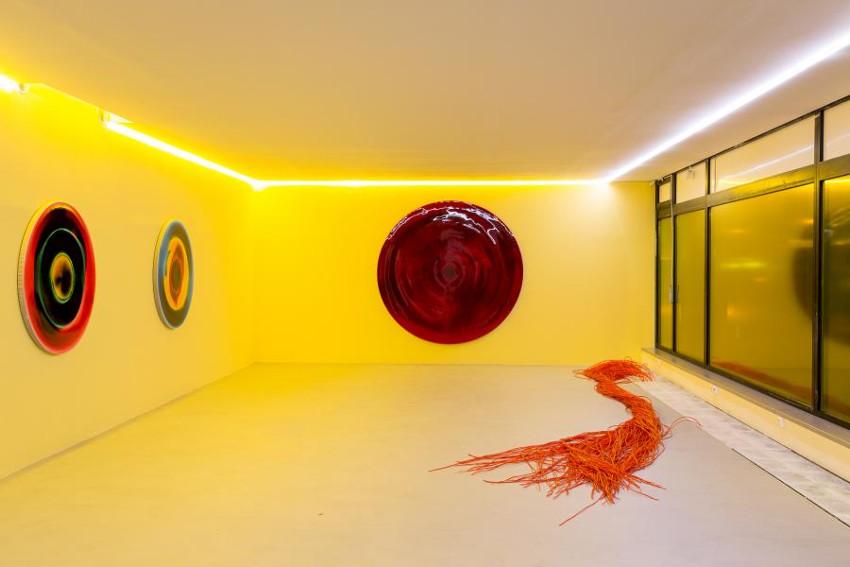
Connecting Points of Milan Houser
Czech artist Milan Houser is proving himself to be a perfect aesthetic representative of this era, in which humanity more and more seeks beauty and meaning in ambiguity. So much is known that we long for the unknown; so much data fills our lives that we yearn for mystery and imagination. In Connecting Point, his current solo exhibition at Kunsthalle Bratislava, Slovakia, Houser both voices those feelings and acts as a harbinger of relief. The tightly packed exhibition features six pieces installed in an L-shaped gallery. Three medium-sized disks filled with concentric circles, and one large-scale red disk hang on the walls; meanwhile, two sculptural “entities” constructed from re-purposed red paint fibers occupy the floor. The gallery space itself could also perhaps be conceived of as a seventh piece in the show. Houser filled the environment with yellow light, which emanates down from the crevice where wall meets ceiling, and covered the windowed walls with yellow film, creating a hazy, glowing atmosphere that evokes the radioactive afterglow of an experiment gone awry. The visual effect raises questions about whether we should look at each work individually as an isolated proposition or if they are all parts in a larger phenomena – more like elements in an installation. For those familiar with the work Houser has done in the past, either reading of the exhibition will likely do. Houser has long been concerned with the fundamental question of whether the things he makes constitutes the work, or if the thing happening within the things he makes is really the work; or whether the underlying ideas behind all of it is what matters. In this exhibition, as usual with Houser, the more we peel back the layers the more questions we find. Houser himself may not completely know what is going on. That only makes him an even more authentic voice for this time. Without knowing the outcome he jumps enthusiastically into his processes, creating self-contained objects and phenomena that are not quite concrete and not quite abstract, but are enigmatic answers to the question of what painting will become next.
Moving Targets
The most eye-catching objects in Connecting Point are the four disks hanging on the walls. The three that are filled with concentric circular patterns invite immediate comparisons to various target paintings by artists like Kenneth Noland, Robert Delaunay, Hilma af Klint, or Kazuo Shiraga. But the luxurious, shiny surfaces Houser has given these works lend industrial qualities that might also evoke comparisons to the Finish Fetish movement of the 1960s, or Minimalist sculpture. Yet something else is going in these disks that makes those comparisons seem feeble – they are endowed with a sense of dynamism, as if they are not finished, but rather snapshots of a process still in motion. This active state of being is a result of the method Houser employs. Setting industrial materials and processes into motion using arbitrary parameters, he leaves room for unexpected visual propositions to be formulated – like a programmer devising cognizant machines with unknown limits then setting them free.

Milan Houser - Connecting Point, installation view at Kunsthalle Bratislava. Courtesy Kunsthalle Bratislava
Houser embraces whatever outcome emerges from his processes, letting the combination of method and object declare its own beauty. Each luminescent, varnish-covered, painterly disk is an embodiment of energy and curiosity. Each is a question asked and answered without fear. The surfaces of the works appeal to the eye like otherworldly jewels, but what what is happening underneath the surface might be more important. We look not only at the surface, but what it hides; we may see ourselves there, or we may see something alien. Either way the work has its own logic – a logic that in this case is most confoundingly expressed by the large-scale red disk that dominates one far wall of the gallery. Placed in another environment, this piece might easily be lost in the background as architectural bling, or confused as decoration. Here, it becomes a totem; a doorway to a transcendent state; a blood-red pool behind a solid surface penetrable only by the mind.

Milan Houser - Connecting Point, installation view at Kunsthalle Bratislava. Courtesy Kunsthalle Bratislava
Trophies of the Unknown
The two sculptural entities Houser made for Connecting Point are presented in such a way that they introduce a disquieting anthropomorphic sensibility to the exhibition. One is a horse-tail-shaped, linear mound of red paint fibers strewn on the floor, like a pile of extension cords in the corner of a film set. The fibers disappear into holes in the floor as though they are alive and oozing forth out from the underneath like tentacles. The other is a boulder-sized organic form on the other side of the gallery, which resembles a sort-of-dreadlock-covered mushroom. Almost comically viewers interact with this object as though it might actually be alive. Is it a pod about to sprout a flower? Is it a creature about to scurry off? Is it a mold spore about to burst? Of course it is only an assemblage of paint fibers. Yet confident and strange, this thing asserts stoically that it has an existence outside of our use for it.

Milan Houser - Connecting Point, installation view at Kunsthalle Bratislava. Courtesy Kunsthalle Bratislava
As has been the case many of his past exhibitions, Houser proves with Connecting Point that he has the ability to unleash something primordial, to create artworks that reach beyond their raison d'être to become dynamic, alive, and caught up in the process of evolving. Though what we see in this exhibition are visual phenomena frozen in a moment, the effects of being in the presence of the works ripples in our mind and sticks with us long after. In his attempt to discover for himself what the contemporary role of painting is, and what its future role might become, Houser has achieved another small, noteworthy milestone. The colorful, vibrant, luminescent objects he presents in Connecting Point are trophies of the unknown: not fragments of realism, though they are ultra-real, but examples of potentialities at the outskirts of the imagination, where intent and surprise mix and become spectacle.
Connecting Point is on view at Kunsthalle Bratislava, Slovakia, through 27 January 2019. The exhibition was curated by Vladimír Beskid.
Featured image: Milan Houser - Connecting Point, installation view at Kunsthalle Bratislava. Courtesy Kunsthalle Bratislava
By Phillip Barcio






